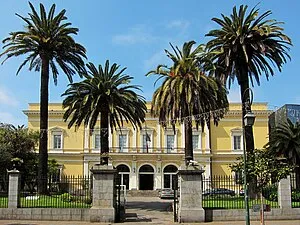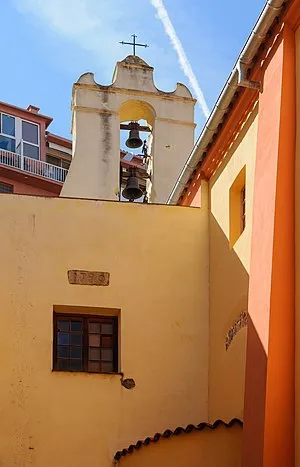



Ajaccio, la Cité Impériale : Un Voyage à Travers l'Histoire et la Culture Corse

Tour Guide
Jenny Multilingual
Welcome to Ajaccio! On this GPS guided audio tour, we will visit 15 stops on a route of 3.46km. This tour focusses mainly on general tourism.
Locatello is an app where you can generate personal audio guided tours. Set your preferred distance, guide, language and theme, and a guided tour is created on the spot.
Walking Time
Distance
stops
Language
Tour Stops

Monument to Napoleon and His Brothers
A monument dedicated to Napoleon Bonaparte and his brothers, featuring a bronze statue of Napoleon on a pedestal surrounded by statues of his brothers Joseph, Lucien, Louis, and Jérôme.

Ajaccio Cathedral
A 16th-century cathedral built between 1577 and 1593, substituting the former Cathedral of Saint-Croix, and attributed to Italian architect Giacomo della Porta, serving as the ecclesiastical seat of the Bishop of Ajaccio.

Église Sant'Eramu d'Ajaccio
A Catholic chapel in Ajaccio, Corsica, built in 1622 by Jesuits, initially dedicated to Ignatius of Loyola. It was renamed after Saint Erasmus of Antiochia in 1815, now serving as the patron saint of seafarers.

Citadelle d'Ajaccio
A fortress built in 1492, Citadelle d'Ajaccio is a stronghold constructed during the Renaissance period, showcasing French military architecture of that time.

Oratoire Saint-Jean-Baptiste d'Ajaccio
A 16th-century oratory in Ajaccio, Corsica, the Oratoire Saint-Jean-Baptiste is a Catholic church with a Manierist-style façade featuring four pilasters, a triangular pediment, and a north-facing tower.

Arboretum des Milelli
A Mediterranean arboretum containing woody plants representative of the region's flora, established in 1993, and open to visitors with an admission fee.

Maison Bonaparte
A museum showcasing the ancestral home of the Bonaparte family, Casa Buonaparte, where Napoleon Bonaparte was born and grew up.

city hall of Ajaccio
A town hall built during the reign of Charles X between 1824 and 1830, housing the Salon napoléonien with Napoleonic paintings, statues, and memorabilia, as well as a collection of coins and medals.

Palais Lantivy
A Neoclassical palace designed by Gisors, the Palais Lantivy features a rectangular plan, two floors, and a facade flanked by two wings, with an atrium and decorated ceilings and walls. It serves as the Corsican Prefecture and General Council headquarters.

Église Saint-Roch d'Ajaccio
A neoclassical church built in 1885, designed by Barthélémy Maglioli, featuring a slender bell tower on the north-eastern side, with renovations in 1923, 1960, and a 2018 restoration project.

Statue du cardinal Fesch
A bronze statue of Joseph Fesch, a French cardinal, created by Vital Dubray in 1855 and installed in 1856 on the courtyard of Palais Fesch in Ajaccio. The statue stands on a stone pedestal with inscriptions about Fesch's life and the artist's name.

Palais Fesch, Ajaccio
A palace built between 1827 and 1837 to house a school, library, and museum, later featuring a funerary chapel housing the burials of the main members of the imperial family.

Chapelle Impériale
A chapel built in 1857 by Kaiser Napoléon III as a fulfillment of a final wish by Kardinal Fesch, an uncle of Napoleon I. It is the burial place of various members of the Bonaparte family, including Carlo di Buonaparte, Laetizia Ramolino, and others.
Audio Preview
30 sec
Chapelle Saint-Roch d'Ajaccio
A Catholic oratory, Chapelle Saint-Roch d'Ajaccio, is a historic place of worship built in 1599, serving the Bruderschaft Saint-Roch and Saint-Sébastien. Its 18th-century Baroque architecture features a vaulted interior, high altar, and ornate decorations.

Musée Fesch
A museum of art, Palais Fesch-musée des beaux-arts, featuring a collection of Italian old masters, including works by Botticelli, Giovanni Bellini, and Titian, with a focus on Early Italian and Renaissance, Roman Baroque, and Neapolitan Baroque art.
Download App
Experience this tour and many more with our mobile app. Available for iOS and Android.
Audio Preview
Tour Map

Quick Facts
- ✓GPS-guided navigation
- ✓Professional audio narration
- ✓Offline maps available
- ✓Premium content included
Why Choose This Tour
Expert Local Guide
Narrated by Jenny Multilingual, specializing in general tourism
Flexible Timing
Take the tour at your own pace, any time of day

